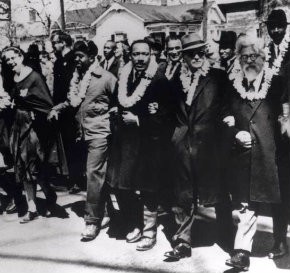Remembering the march to Montgomery

In 1965, Martin Luther King Jr. sent a telegram to religious leaders asking them to come to Alabama to lend their support to the civil rights movement. It was the first time King had appealed directly to the conscience of the broader, mainly white, religious community. Describing the events of March 7, when dozens of black protesters were beat by white law enforcement officers, King wrote the following:
In the vicious maltreatment of defenseless citizens of Selma, where old women and young children were gassed and clubbed at random, we have witnessed an eruption of the disease of racism which seeks to destroy all America. No American is without responsibility....I call, therefore, on clergy of all faiths to join me in Selma for a ministers march to Montgomery.
The National Council of Churches issued an appeal of its own. Thousands of religious leaders and laypeople began to arrive in Selma to express their solidarity with the cause. John E. Hines, then the Episcopal presiding bishop, joined 500 other Episcopalians in making the trek—despite the objections of Alabama’s diocesan bishop, Charles C.J. Carpenter, who called the Selma protests “a foolish business and sad waste of time.” Carpenter urged his fellow Episcopalians to go home, but they did not.
Now, nearly a half century later, plans are taking shape in Montgomery to honor those who participated in what would become a historic five-day march from Selma to Montgomery—considered by many to be the most important such march in U.S. history, because it mobilized a nation and led to the passage of the Voting Rights Act of 1965.




